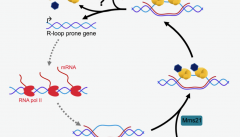
Teams
Convergent mechanisms sense transcriptional and genotoxic stresses
Bravo à Marion, de l'équipe SMAL, pour son papier sur des mecanismes de sensing du stress (transcriptionnel ou genotoxique) chez la levure. Le travail a été fait à Marseille UMR7258, et a été publié fin 2023.
A R-loop sensing pathway mediates the relocation of transcribed genes to nuclear pore complexes A. Penzo, M. Dubarry, C. Brocas, M. Zheng, R. M. Mangione, M. Rougemaille, et al. Nat Commun 2023 Vol. 14 Issue 1 Pages 5606
DOI: 10.1038/s41467-023-41345-z https://www.ncbi.nlm.nih.gov/pubmed/37730746
Nuclear pore complexes (NPCs) have increasingly recognized interactions with the genome, as exemplified in yeast, where they bind transcribed or damaged chromatin. By combining genome-wide approaches with live imaging of model loci, we uncover a correlation between NPC association and the accumulation of R-loops, which are genotoxic structures formed through hybridization of nascent RNAs with their DNA templates. Manipulating hybrid formation demonstrates that R-loop accumulation per se, rather than transcription or R-loop-dependent damages, is the primary trigger for relocation to NPCs. Mechanistically, R-loop-dependent repositioning involves their recognition by the ssDNA-binding protein RPA, and SUMO-dependent interactions with NPC-associated factors. Preventing R-loop-dependent relocation leads to lethality in hybrid-accumulating conditions, while NPC tethering of a model hybrid-prone locus attenuates R-loop-dependent genetic instability. Remarkably, this relocation pathway involves molecular factors similar to those required for the association of stalled replication forks with NPCs, supporting the existence of convergent mechanisms for sensing transcriptional and genotoxic stresses.

